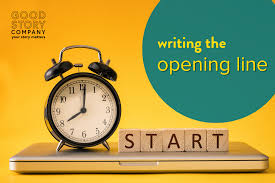How to Craft the Perfect Opening Line for Your Novel—because first impressions matter, and nowhere is that more true than in the first sentence of a story. The opening line is your book’s handshake with the reader, the moment where curiosity is either sparked or lost. A great story opener can set the tone, establish voice, and compel readers to keep turning pages. But how do you write one that truly resonates? In this blog, we’ll break down the elements of a perfect opening line and explore strategies to help you craft an unforgettable beginning.

Why the Opening Line Matters?
The first line of your novel isn’t just a formality—it’s a promise to your reader. It tells them what kind of story to expect and whether it’s worth their time. In an age where readers can preview books with a single click, your first sentence needs to stand out more than ever.
A strong opening line can:
- Establish tone and voice immediately
- Introduce a compelling character or situation
- Create intrigue or tension
- Set expectations for the narrative
Elements of a Great Opening Line
- Voice That Grabs Attention
Voice is the personality of your narrative. A bold, witty, or intriguing voice can hook readers instantly. Think about how your protagonist speaks or how your narrator views the world. Is it cynical? Playful? Mysterious?
Example: “It was a bright cold day in April, and the clocks were striking thirteen.” — George Orwell, 1984
- Immediate Conflict or Tension
Conflict draws readers in. Starting with a problem, contradiction, or mystery plants questions that demand answers.
Example: “The man in black fled across the desert, and the gunslinger followed.” — Stephen King, The Gunslinger
- A Hint of the Bigger Picture
Your opening line should reflect the theme or larger narrative. It doesn’t have to give away the plot but should resonate with the story’s essence.
Example: “All happy families are alike; each unhappy family is unhappy in its own way.” — Leo Tolstoy, Anna Karenina
- Strong Imagery or Detail
Use vivid or surprising imagery that ignites the reader’s imagination. A well-crafted image in the first line can pull readers into your world effortlessly.
Example: “I was born twice: first, as a baby girl… and then again, as a teenage boy.” — Jeffrey Eugenides, Middlesex
Tips to Craft Your Opening Line
- Write it last. Sometimes the perfect opening comes only after you’ve written the entire novel. Revisit and rewrite it as needed.
- Keep it concise. Aim for clarity, not complexity. The goal is to pull readers in, not confuse them.
- Test multiple versions. Draft 5–10 different openings to find what works best. Compare tone, style, and impact.
- Read it aloud. If it rolls off the tongue smoothly and sounds powerful, it’s likely effective.
- Ask a question or make a bold statement. Either device can stir curiosity instantly.
Common Mistakes to Avoid
- Starting with cliché scenes like waking up from a dream or describing the weather (unless there’s a unique twist).
- Overloading with exposition. Save the background for later; intrigue is more powerful than explanation.
- Lack of clarity. Don’t sacrifice meaning for mystery. The reader should be curious, not confused.
blogs here https://novelnot.com/blogs/
